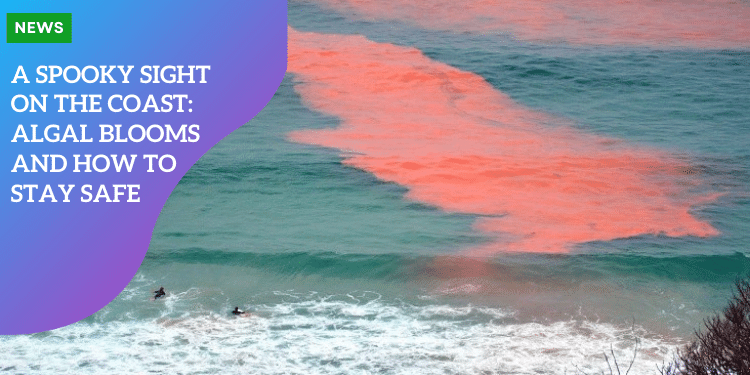A Spooky Sight on the Coast: Algal Blooms and How to Stay Safe

Algal Blooms and How to Stay Safe
Beach days are a cherished part of life for many coastal residents. But what happens when a vibrant green, red, or brown mass disrupts the idyllic blue waters? This is the unsettling sight of an algal bloom, a natural phenomenon that can pose health risks to beachgoers.
Unwelcome Visitors: Identifying Algal Blooms
Recent samplings along the Perth coastline have confirmed the presence of patchy algal blooms, specifically Trichodesmium cf erythraeum. These free-floating marine microorganisms can form dense surface scums, often resembling oil slicks with their brown, red, orange, or yellow hues. As they decompose, the blooms take on a more unsettling pinkish or pale green color.
When Beauty Turns Bracing: Potential Health Concerns
While algal blooms can appear mesmerizing, they can also pose health risks. Contact with the algae can trigger skin irritation, particularly for individuals with sensitive skin. Stings, tingling sensations, and rashes are commonly reported symptoms. Additionally, exposure may lead to respiratory difficulties, sore throat, nausea, and a general feeling of weakness.
Expert Guidance: Protecting Yourself from Algal Blooms
Fortunately, there are ways to stay safe during an algal bloom event. Dr. Jared Koutsoukos, a senior scientific officer at WA Health, emphasizes the importance of avoiding contact with discolored water or visible scum. Activities like swimming, diving, kayaking, jet skiing, and fishing should be suspended in affected areas.
Dr. Koutsoukos further advises against consuming shellfish harvested from waters experiencing algal blooms. These filter feeders can accumulate algal toxins, posing a risk to human health.
A Unified Approach: Monitoring and Management Efforts
To safeguard public health, WA Health is actively collaborating with the Department of Water and Environmental Regulation (DWER) and local government authorities. Together, they are implementing a multi-pronged approach:
- Monitoring: Regular water sampling and observation help track the movement and extent of the algal blooms.
- Assessment: Scientists analyze the specific type of algae present and determine the potential health risks associated with the bloom.
- Action: Where necessary, health warning signs are erected in impacted foreshore areas to alert beachgoers of the potential dangers.
The Ever-Changing Seascape: The Dynamic Nature of Algal Blooms
Algal blooms are a dynamic phenomenon, shaped by wind and tides. They can appear suddenly and dissipate just as quickly, making them challenging to predict. Furthermore, they have the potential to cover vast stretches along the WA coastline, necessitating continuous vigilance and monitoring efforts.
Taking Charge of Your Safety: What to Do During an Algal Bloom
If you encounter discolored water or algal scum, the most important step is to avoid contact altogether. Rinse any exposed skin thoroughly with clean, fresh water. Should you experience any adverse health effects after potential exposure, seek medical attention promptly.
Working Together: Community Engagement for a Safer Coastline
Everyone plays a role in maintaining a healthy coastline. Community members are encouraged to report sightings of algal blooms or water discoloration through designated channels like [email protected] or Pollution Watch. This information is crucial for authorities to track the movement of the blooms and take appropriate action.
Conclusion: Enjoying the Coast Responsibly
The allure of the coast is undeniable, offering a chance to relax and reconnect with nature. However, it’s vital to be aware of potential risks like algal blooms. By heeding expert advice, exercising caution, and reporting sightings, we can all contribute to a safer coastline and ensure a more enjoyable experience for everyone. Remember, a collaborative effort between authorities and the community is essential to safeguard public health and preserve the beauty of our precious coastal environment.
Understanding Algal Blooms: A Marine Mystery
Algal blooms occur when favorable conditions trigger an explosion in the population of microscopic marine plants, known as phytoplankton. Nutrient enrichment from runoff or upwelling events can provide the perfect recipe for a bloom. While some algal blooms are harmless, others, like the Trichodesmium cf erythraeum currently affecting the Perth coastline, can produce toxins that irritate the skin and respiratory system.
The Impact on Marine Life
The presence of algal blooms can also disrupt the delicate balance of marine ecosystems. As the algae decompose, they deplete oxygen levels in the water, creating hypoxic zones where marine animals struggle to survive. Fish kills are a common consequence of severe algal blooms.
Long-Term Monitoring and Research
Scientists are actively researching the causes and impacts of algal blooms. Long-term monitoring programs are essential to understand the factors that trigger these events and develop effective mitigation strategies. By working together, we can learn to coexist with these natural phenomena and protect the health of our oceans.






